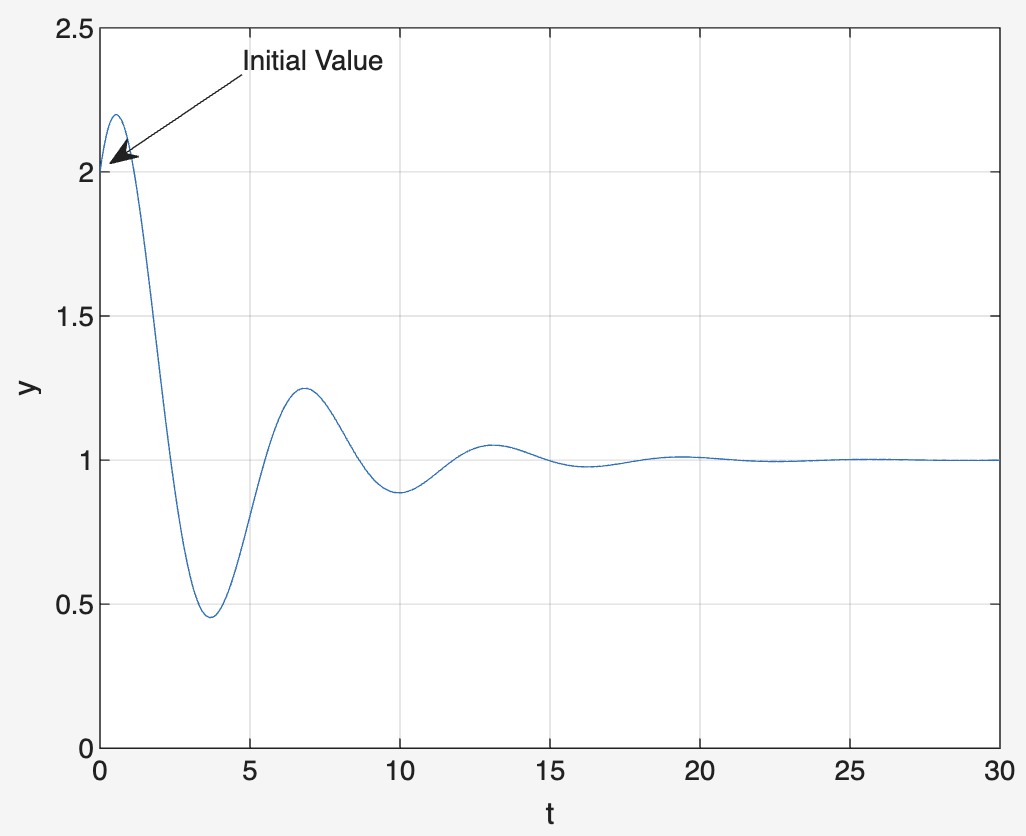Initial Value Theorem
Introduction¶
In Control Theory and Laplace transform, the initial value theorem helps to find the time domain value of function \(x(t)\) at time t=0 (initial time) without needing to find the inverse Laplace transform \(\mathcal{L}^{-1}[X(s)]\). Finding inverse Laplace transform could be complicated and time consuming.

Definition¶
Initial value theorem of Laplace transform states that,
$$x(t)\leftrightarrow{}X(s)$$
Then,
$$\lim_{t\rightarrow{}0}x(t)=x(0)=\lim_{s\rightarrow{}\infty}sX(s)$$
For z-transforms, if
$$x[n]\leftrightarrow{}X(z)$$
Then,
$$x[0]=\lim_{z\rightarrow{}\infty{}}X(z)$$
Example of Initial Value theorem¶
Find the initial time domain value of function :
$$X(s)=\cfrac{1}{s}+\cfrac{1}{s^2+2s+2}+\cfrac{s+1}{s^2+2s+2}$$
- Multiply the transfer function \(X(s)\) by \(s\).
- Take the limit of \(sX(s)\) as \(s\rightarrow{}\infty{}\)
- Result is value of \(x(t)\) when \(t=0\).
$$\lim_{s\rightarrow{}\infty{}}s\left(\cfrac{1}{s}+\cfrac{1}{s^2+2s+2}+\cfrac{s+1}{s^2+2s+2}\right)=2$$
The initial time domain value is 2.
Inverse Laplace Transform method
Using partial fractions we can find the inverse laplace transform of the above function. We get, $$x(t)=1+e^{-t}[\sin(t)+\cos(t)]$$ If we substitute \(t=0\), we get \(x(0)=2\) which matches initial value theorem.
Derivation of Initial value theorem for Laplace transform¶
Laplace transform of signal \(x(t)u(t)\) is :
$$\mathcal{L}[x(t)]=X(s)=\int_{0}^{\infty}x(t)e^{-st}dt$$
Taking derivative of both sides :
$$\mathcal{L}[\cfrac{dx(t)}{dt}]=\int_{0}^{\infty}\cfrac{dx(t)}{dt}e^{-st}dt$$
Using derivative in time-domain property of Laplace transform,
$$\mathcal{L}[\cfrac{dx(t)}{dt}]=\int_{0}^{\infty}\cfrac{dx(t)}{dt}e^{-st}dt=sX(s)-x(0)$$
$$\implies{}\lim_{s\rightarrow{}\infty{}}\int_{0}^{\infty}\cfrac{dx(t)}{dt}e^{-st}dt=\lim_{s\rightarrow{}\infty{}}\left(sX(s)-x(0)\right)$$
$$\implies{}0=\lim_{s\rightarrow{}\infty{}}\left(sX(s)-x(0)\right)$$
$$\implies{}x(0)=\lim_{s\rightarrow{}\infty{}}sX(s)$$
See also : Final Value Theorem